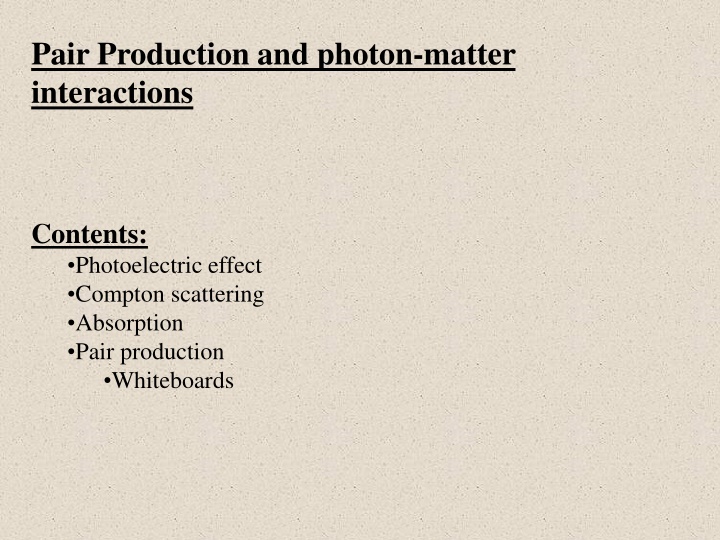
Photon-Matter Interactions: Understanding Pair Production and More
Explore the fascinating interactions between photons and matter, including the photoelectric effect, Compton scattering, absorption, and pair production. Discover how photons can create electron-positron pairs and other intriguing phenomena in the world of particle physics.
Download Presentation

Please find below an Image/Link to download the presentation.
The content on the website is provided AS IS for your information and personal use only. It may not be sold, licensed, or shared on other websites without obtaining consent from the author. If you encounter any issues during the download, it is possible that the publisher has removed the file from their server.
You are allowed to download the files provided on this website for personal or commercial use, subject to the condition that they are used lawfully. All files are the property of their respective owners.
The content on the website is provided AS IS for your information and personal use only. It may not be sold, licensed, or shared on other websites without obtaining consent from the author.
E N D
Presentation Transcript
Pair Production and photon-matter interactions Contents: Photoelectric effect Compton scattering Absorption Pair production Whiteboards
Photoelectric effect 1. Photon knocks electron from atom 2. Photon disappears in the process
Compton Scattering 1. Photon bounces off electron 2. Electron absorbs some energy 3. Photon has longer wavelength after collision
Absorption 1. Photon hits electron in orbital 2. Electron moves to excited state 3. Photon disappears in the process 4. Only for photons with the right energy
Pair production 1. Photon with sufficient energy passes near nucleus 2. Energy of photon turns into matter 3. Pair of matter/anti matter is created 4. Nucleus must carry off some momentum annihilated presently! Help me! I m going to be Positron m = 9.11 x 10-31 kg Charge = +e Electron m = 9.11 x 10-31 kg Charge = -e
Example 1: What energy photon (in MeV) is needed to create a electron- positron pair each with a kinetic energy of 0.34 MeV? What is the wavelength of that photon? Photon energy = energy to create matter + kinetic energy
Example 2: A 0.00025 nm photon creates a electron positron pair. What is the kinetic energy of each particle?
Whiteboards: Pair production 1 | 2 | 3
A photon creates a electron-positron pair each with a kinetic energy of 0.170 MeV. What is the energy of the photon? (in MeV) photon energy = energy to create mass + kinetic energy = .511 MeV + .511 MeV + .170 MeV + .170 MeV = 1.362 MeV 1.362 MeV
A 2134 MeV photon creates a proton, antiproton pair, each with how much kinetic energy? (2) Proton rest mass = 938 MeV photon energy = energy to create mass + kinetic energy 2134 MeV = 938 MeV + 938 MeV + kinetic energy kinetic energy = 258 MeV/(2 particles) = 129 MeV 129 MeV
A photon with a wavelength of 5.27113x 10-13 m creates a electron- positron pair with how much kinetic energy each? (answer in keV) E = hf = hc/ E = hc/ , = (6.626 x 10-34 Js)(3.00 x 108 m/s)/(5.27113x 10-13 m) = (3.77111x 10-13 J)/(1.602 x 10-19 J/eV) = 2354000 eV = 2354 keV photon energy = energy to create mass + kinetic energy 2354 keV= 511 keV + 511 keV + kinetic energy kinetic energy = 1332 keV/(2 particles) = 666 keV 666 keV
Solving pair production E = hf = hc/ E = mc2 E - Energy m - mass c = 3.00 x 108 m/s 1 eV = 1.602 x 10-19 J Example 1: What energy photon (in MeV) is needed to create a electron-positron pair each with a kinetic energy of 0.34 MeV? What is the wavelength of that photon? Photon energy = energy to create matter + kinetic energy
Solving pair production E = hf = hc/ E = mc2 E - Energy m - mass c = 3.00 x 108 m/s 1 eV = 1.602 x 10-19 J Example 3: A 0.00025 nm photon creates a electron positron pair. What is the kinetic energy of each particle?
